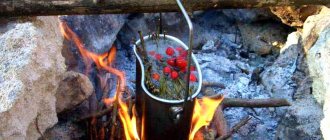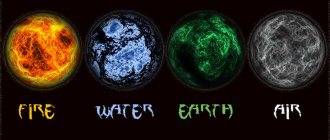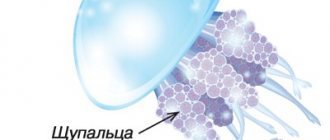There are a lot of people who like to vacation in countries with hot climates. People go there all year round to sunbathe and swim to their heart's content. But tourists often know very little about the nature of these exotic places. The warmer the climate, the more diverse the flora and fauna, which means the more dangerous plants and animals, the more toxic their poison. One of these heat-loving poisoners is the scorpion, whose bite is similar in strength to that of a snake. Several species of these arthropods live in the south of Russia.
Let's find out who scorpions are, where they are found in our country, how their poison affects humans and what to do if they are bitten.
Who are Scorpios
These are poisonous animals of the order of arthropods belonging to the class of arachnids. They are the oldest representatives, whose origin begins in the Silurian period of the Paleozoic, that is, they have existed for more than 400 million years. Outwardly they resemble a small crayfish. The size of the largest scorpions does not exceed 25 centimeters. There are also miniature representatives of the species - a little more than 1 cm.
The scorpion's body is divided into the cephalothorax and abdomen. There are six pairs of limbs, four of which are walking. The first pair is modified in the jaw - chelicerae. With their help, the scorpion captures prey. The anterior part of the abdomen is adjacent to the cephalothorax and forms the torso. The posterior section, which looks like a tail, consists of six segments. The last of them ends with a sting curved upward and contains two poisonous glands. Their ducts open to the side of the needle tip. The body is covered with a chitinous shell and a layer of wax that prevents water loss.
“Scorpion sting” is nothing more than a figurative expression that actually means an injection with a poisonous sting.
Scorpions are predatory animals. They feed on insects and small mammals. Most species hunt at night, and during the day they hide under stones, in soil voids, under the bark of trees, and in crevices of various buildings. Scorpio's enemies are spiders, snakes, lizards, owls, bats, hedgehogs and shrews. In addition, they are characterized by cannibalism - a strong one, under a convenient combination of circumstances, will eat a weaker representative of the species.
Briefly about Scorpios
These creatures belong to the class of arachnid invertebrates. They live mainly in Africa and South America, but you can find poisonous and harmless scorpions in the Caucasus and Crimea. Locals and tourists have encountered scorpions in Sochi, although the species found in southern Russia pose no threat to humans.
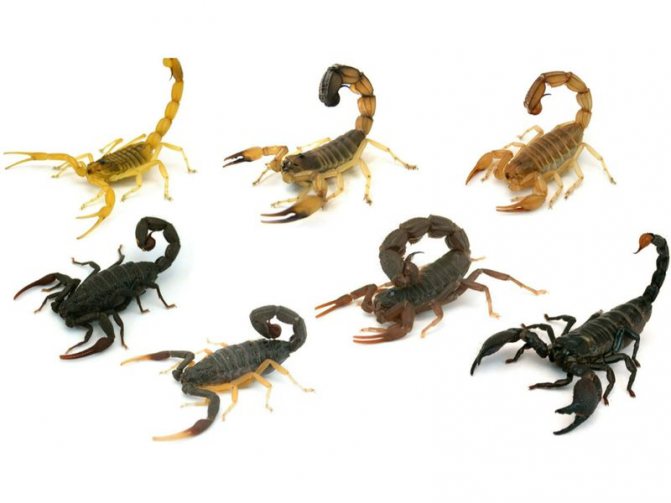
Arthropods sting with an anal blade - the telson. There is a needle at the end of the organ. Scorpion venom comes from it. The question arises: what is dangerous about a poisonous secretion? It contains neurotoxic polypeptides. The intensity of the poison is determined by species. There are different types of scorpions:
- imperial scorpion - has an enviable size and often appears in home terrariums. It rarely stings and reproduces well in captivity. For humans, such a scorpion is dangerous only during the period of breeding, although its poison is low-toxic;
- Caucasian scorpion - belongs to the butids, has a small size - about 8 cm. Inhabits mainly deserts and semi-deserts. The bites of an arachnid of this species are characterized by severe pain, but are not too dangerous for humans;
- Crimean scorpion - found mainly on the southern coast of Crimea. It has a light yellow color and brown claws. Refers to relict individuals;
- Abkhazian variety - also known as Mingrelian, found in Abkhazia, Georgia, Turkey. Is the bite of such a scorpion dangerous? If there is no intolerance to the poison, then there will be no threat to life;
- thick-tailed scorpion - belongs to the butids, has a black or yellow color, the thick-tailed scorpion has a massive “tail”. Its bite can lead to death. The risk group includes children, the elderly, people with heart disease;
- Italian scorpion - stings painfully, but does no harm. It has a modest size of up to 5 cm. It lives mainly in Western Europe, but can be found in the Caucasus;
- Palestinian yellow scorpion - or genuris, bites painfully, is highly toxic;
- Ranatra is a water scorpion that has nothing in common with arachnids, although it is an arthropod. The bite of water bugs burns, but no more.
Where are they found in Russia?
There are about 1,750 species of scorpions. They inhabit regions with a hot climate - equatorial, tropical and adjacent zones.
There are about 15 species of scorpions in Russia. The most numerous of them are the following.
- A motley scorpion that lives in the Lower Volga region and the Caucasus. Its color is yellowish, with a green tint. The length does not exceed 6.5 centimeters.

- The Crimean scorpion, living in the southern regions of Crimea, is light yellow in color and 3.5–4 cm in size.

- Caucasian scorpion, which can be colored in various shades of yellow. Its size is about 8 cm.

- The Mingrelian scorpion, which lives in the valleys of the southern rivers of Russia, is reddish-brown, up to 4 centimeters long.

- The Italian scorpion, which inhabits the Black Sea coast from Sochi to Batumi, has a red-brown or dark brown color. The average length of its body is 5.5 cm.
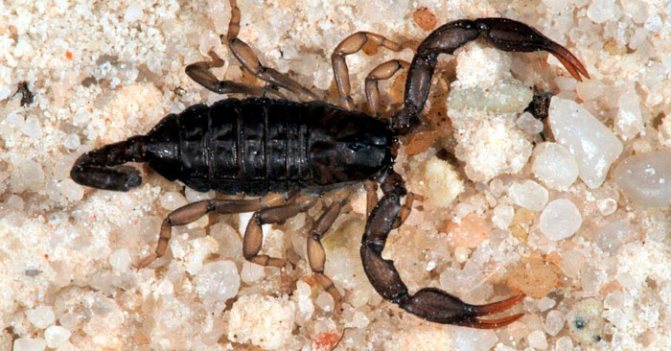
The motley and Caucasian scorpions have a larger venomous section of the abdomen and are therefore more dangerous than other Russian representatives of this order. However, even among them there are differences. When a motley scorpion bites, local signs of poisoning predominate. And its Caucasian relative causes toxicosis, in which both local and general symptoms are sharply expressed.
Is the water scorpion dangerous?
This is the name of the family of water bugs because of their strong external resemblance to the land scorpion. But unlike the usual one, the water tail does not carry poison. With the help of this tail, the water bug breathes when it is under water. In fact, it is a breathing tube. Lives in bodies of water with standing water or with a weak current - lakes, ponds, ditches, streams.
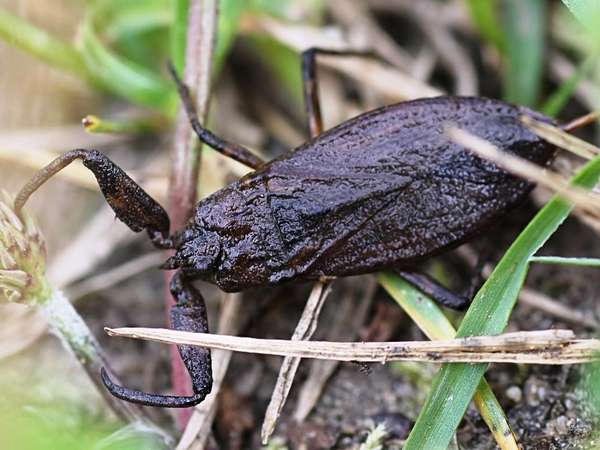
Distributed in the tropics, but has also taken root in Europe. The water bug is easy to miss due to its camouflage coloring and small size (up to 4.5 cm). If it gets scared, it might bite. The bite is painful, but not dangerous. No special treatment is needed, although the pain may bother you for some time.
The wound is treated with an antiseptic. Itching and discomfort are relieved with a cold compress. If the itching does not go away, take antihistamines.
Scorpion poison
Toxins are produced in two special glands located in the last segment of the scorpion's abdomen. Outside, they are surrounded by a layer of striated muscles, the contraction of which releases a poisonous secretion. The toxin is introduced into the victim's body by pricking with a sting.
Scorpion venom contains:
- carbohydrates;
- biogenic amides;
- histamine;
- polyamines - spermidine, putrescine;
- toxic polypeptides;
- enzymes - phospholipase A and B, hyaluronidase, acid phosphatase, ribonuclease, acetylcholinesterase, nucleotidase, phosphodiesterase.
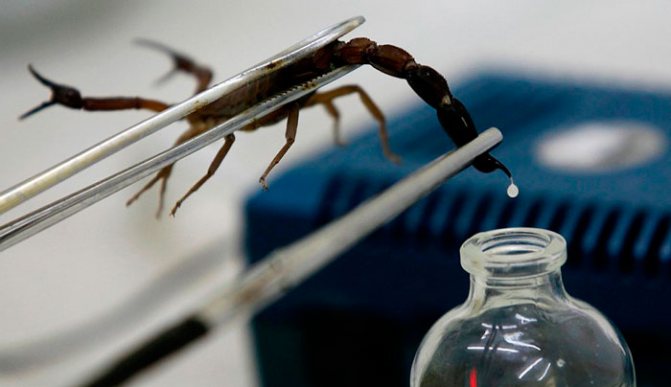
The strength of scorpion venom depends on the content of enzymes and polypeptides in it, which are neurotoxins. They are divided into substances that are poisonous to insects and mammals. There are up to 40 varieties of these compounds. Toxins consist of 33–36 polypeptide chains; milkotoxins have a more complex composition (65–67 amino acids). Scorpions are able to “adjust” their poison to the inhabitants of the area where they live. When the number or type of insects and animals in their habitat changes, the composition of toxins in their glands is transformed.
Scorpions use their venom sparingly, using it in the amount necessary to kill the victim. However, for self-defense they use maximum doses of the toxin.
Effect of scorpion venom on humans
There are about fifty species of animals of this order, the poison of which poses a danger to life. As a rule, a single sting of a scorpion living in Russia is not fatal to an adult. But it is dangerous for children. The location of the lesion also matters. Life-threatening poisoning occurs if a scorpion stings in areas adjacent to large blood vessels.
The strength of the poison depends on the type of scorpion, its habitat, the amount of toxin injected and the time of year when the accident occurred. World statistics on mortality from their bites is 0.27% of all victims.
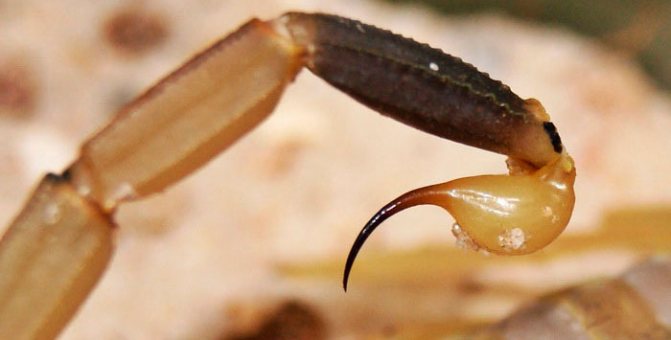
How does scorpion venom affect humans? It has neurotropic and cardiotoxic effects. The poison disrupts the permeability of sodium channels for ions, which leads to persistent depolarization of cell membranes. Changes the conduction of nerve impulses in the central nervous and autonomic systems. When poisoned by scorpion venom, the content of acetylcholine and norepinephrine in the bloodstream increases. The hemolytic effect, which is manifested by the destruction of red blood cells, is less pronounced.
How to Avoid a Scorpion Sting
To avoid becoming a victim of a scorpion, it is recommended:
- for overnight stays in nature, where there is a high probability of the presence of scorpions, choose flat surfaces, be sure to clear them of foreign objects: dry branches, stones, etc.;
- tightly curtain the entrance to the tent;
- before going to bed, conduct a thorough inspection of tents and sleeping bags;
- shake out clothes and shoes in the morning;
- do not wander along rocky slopes at night, do not collect firewood for a fire;
- do not walk without shoes on sandy beaches and deserted places, as scorpions like to burrow into the sand to a shallow depth;
- When meeting a dangerous insect, you should not tease it or try to touch it by the tail.
It is worth understanding the danger scorpion venom poses to the body. Being a neurotoxic polypeptide, this substance is characterized by the property of causing allergic reactions, stimulating the release of stress hormones and negatively affecting brain tissue and nerve cells.
Symptoms
A scorpion sting, according to the International Classification of Diseases, Tenth Revision - ICD-10, has a code - X22. It belongs to the heading “Contact with poisonous animals and plants” (X20-X29).
A feature of a scorpion sting is the rapid onset of symptoms of poisoning, as well as their two-phase nature, when, after an initial improvement in the condition, a repeated deterioration occurs. Therefore, in case of a scorpion bite, it is especially important to follow the first aid algorithm and urgently transport the victim to the hospital. If a relapse occurs, hospitalization is necessary.
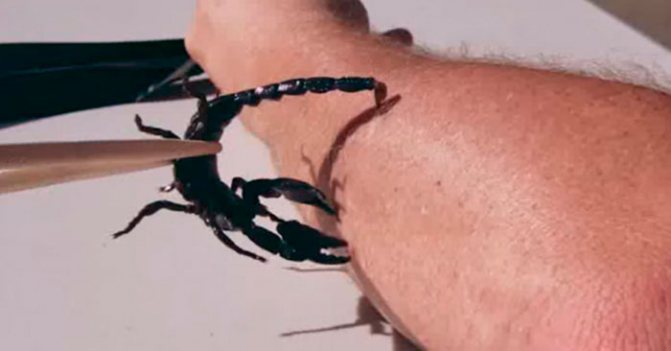
The first signs of poisoning appear immediately after the bite. The main symptoms of toxicosis, called scorpionism, are presented as follows (as the frequency of occurrence decreases):
- severe pain at the site of the bite;
- anxiety;
- nausea and vomiting;
- tachycardia and arrhythmia;
- hypotension;
- convulsions;
- loss of consciousness, coma.
A characteristic feature of a scorpion sting is unbearable burning pain. The damaged area quickly turns red and swells. Sometimes blisters appear, as in a thermal burn, containing clear liquid. Dense red strands appear at the locations of the lymphatic vessels. Then the skin in the affected area becomes blue. Lymph nodes enlarge. Local manifestations reach their maximum 6–8 hours after the bite.
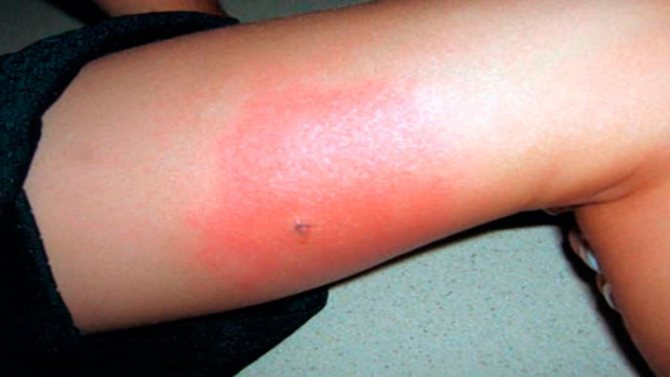
Symptoms of general intoxication include:
- headache;
- increase or decrease in body temperature, chills;
- dilated pupils, blurred vision, lacrimation;
- drooling, nausea and vomiting;
- diarrhea;
- rhinorrhea.
The neurotoxic effect of the poison is manifested by signs of damage to the nervous system:
- cramps and tremors in the fingers and toes;
- fasciculations (muscle twitching) of the tongue;
- difficulty swallowing;
- shortness of breath, with active movements of the chest;
- fear of death, apathy, drowsiness;
- speech disorder.
The cardiotoxic effect of the poison is reflected by the following symptoms:
- pain in the heart and behind the sternum;
- hypertension;
- tachycardia;
- heart rhythm disturbances (extrasystole, sinus or atrial fibrillation);
- decrease in blood pressure.
The effect of poison on the nervous and cardiovascular systems is two-stage - initial excitation and subsequent inhibition. Activation of the cardiovascular system, manifested by chest pain, hypertension and rhythm disturbances, is replaced by severe hypotension. Pulmonary edema can occur both when pressure increases and when it decreases. Fluctuations in hemodynamics can cause the occurrence of foci of ischemia in the heart, such as infarctions. In addition, myocarditis, an inflammation of the heart muscle, can develop under the influence of the toxin.

Death from a scorpion sting occurs as a result of cardiac arrest due to rhythm disturbances and myocardial infarction. Death is also possible with anaphylactic shock, pulmonary edema and paralysis of the respiratory muscles.
Is a scorpion sting dangerous for humans?
If you are unlucky enough to encounter a poisonous scorpion, rest assured that it is dangerous for you. The danger in this case lies in the venom of the scorpion, which is rich in various unhealthy components.
The components of the poisonous substance in the sting of a scorpion are:
- neurotoxins (destroy the central nervous system and negatively affect human brain activity);
- antigens (cause a severe allergic reaction in the bitten person);
- other substances that disrupt the functioning of the cardiovascular system and contribute to the release of cortisol (stress hormone) in the body.
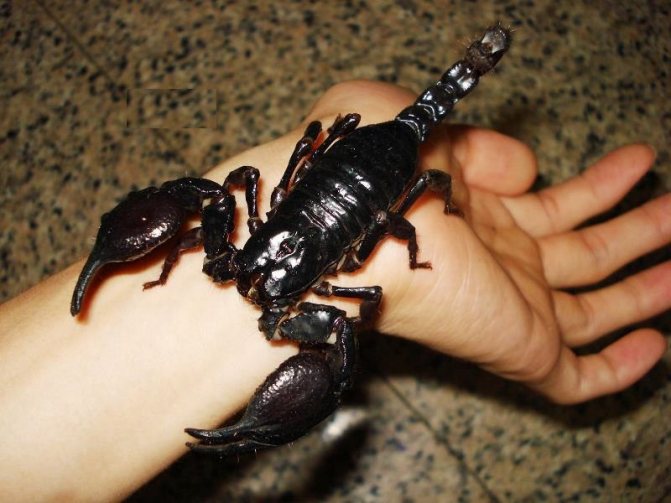
Scorpion
First aid for a scorpion sting
Emergency measures are aimed at preventing further entry of poison into the body, reducing its absorption and reducing the damaging effect of the toxin already circulating in the blood. Timely self and mutual assistance is especially important due to the rapid onset of action of the poison.
What should you do if you are bitten by a scorpion? First aid includes the following emergency measures.
- Flush the scorpion sting wound with plenty of water.
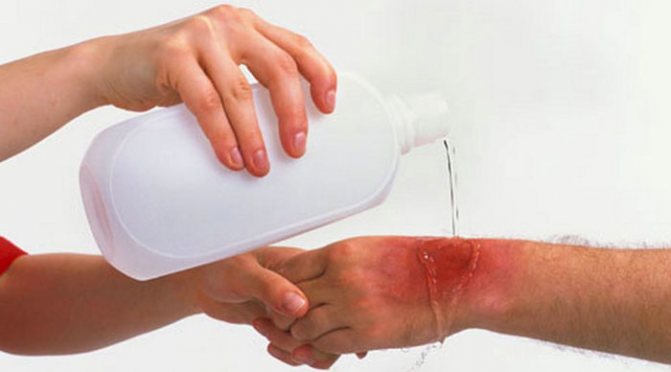
- Suction of poison. This measure allows you to remove up to half of the toxic substance if it is performed immediately after the bite. The procedure should last within half an hour.
- Treatment of the wound with any alcohol-based solution. Then a sterile bandage or a clean, ironed handkerchief is applied to it.
- The victim must lie down. If a scorpion stings an arm or leg, then it is necessary to create a stationary position for the limb, since the spread of poison throughout the body occurs due to the flow of lymph, the speed of which decreases at rest. For immobilization, strong improvised means and bandages of the “kerchief” type are used.
- Cooling the bite site. To treat and disinfect a wound, it is better to use cool or cold alcohol solutions. Cold can then be applied to the injury site through a bandage.
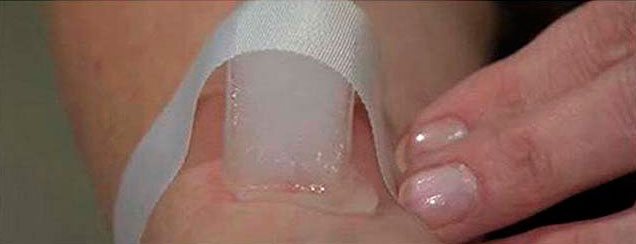
- Drinking heavily frequently. Taking liquids reduces the concentration of poison in the blood and promotes its faster elimination. Warm liquids that have a diuretic effect are useful. For example, coffee, lingonberry decoction.
- Oral administration of drugs. For pain relief - quick-acting analgesics, such as Analgin, Ketorolac, Nurofen. To reduce intoxication and allergic phenomena, take glucocorticoids - Prednisolone, as well as antihistamines - Diphenhydramine, Suprastin, Tavegil.
- Transporting the victim to the hospital.
After emergency measures are provided, the patient must be transported to a medical facility by ambulance or any available transport. It should be remembered that poisoning has two phases, when after improvement with first aid, after a short period of time, a sharp deterioration in the condition occurs.
First aid for a scorpion sting
Scorpios: getting to know your abuser
Scorpions are a category of arachnids that can be either deadly or harmless. The poison is contained in a sac located on the tail, directly next to the sting. It consists of the following components:
- antigens are toxic substances that cause allergic reactions in the body;
- neurotoxic polypeptides that can completely destroy the structure of brain tissue and nerve cells;
- a toxic substance released from an insect sting stimulates the release of stress hormones, having a depressing effect on the state of the central nervous system.

Scorpions look very much like crustaceans. Their body length varies from 3 to 18 cm, they have 2 claws, 4 pairs of legs and a sting that secretes a specific poisonous substance.
Types of arthropods and their danger to humans
Scorpio is a representative of arthropods that produce a toxic substance in their glands. It never bites a person first, but uses its venom for self-defense. He releases it when he senses mortal danger.
A special insect called the water scorpion stands out. It is only the “namesake” of a dangerous arthropod, since it is a bug that lives in bodies of water with stagnant water. But the similarity of insects is only external, since the aquatic species, unlike its “brother,” is completely safe for humans. The only danger is burning and redness of the skin.
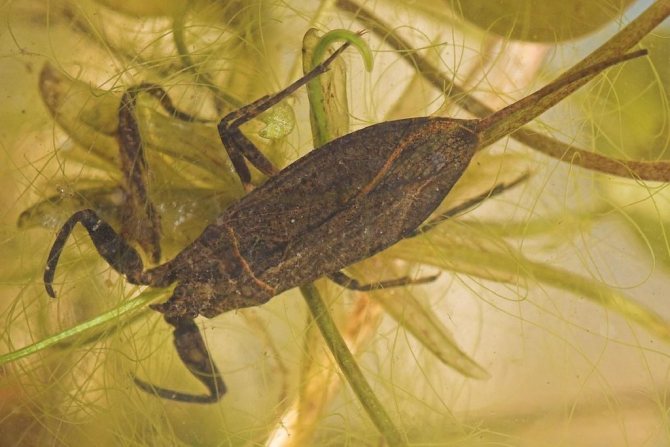
But since it bites very painfully, after the bite you need to apply a cold compress to the injury site and take an antihistamine. After all, the substance secreted by the bug can also cause an allergic reaction.
Where can you encounter a threat?
Answering the question whether a scorpion bite is fatal, experts emphasize that more than 500 species of these arthropods are considered deadly to humans. They live in the mountainous regions of Chechnya, Dagestan, the Caucasus, and the Volga region. Certain species of scorpions have chosen the Black Sea coast.
Why is scorpion venom dangerous?
After a scorpion sting, the victim definitely requires medical attention, because the incident can cause death. Insects with a black color are considered the most dangerous. Their poison leads to paralysis of vital organs and systems in the human body.
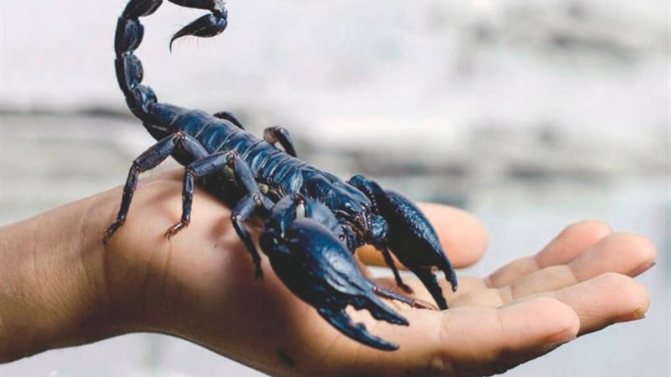
Individuals of yellow and red-brown color are considered the least dangerous, since they are not poisonous. The injuries resemble those caused by bees and are most often accompanied by swelling and redness at the site of the injury.
There is no special antidote for scorpion stings. But intramuscular injections of Adrenaline, Atropine or Novocaine help slow down the absorption of the toxic substance.
Treatment
In case of poisoning after a scorpion sting, complex therapy is carried out - specific, detoxification and symptomatic. Most adults can be treated in an outpatient setting. Children must be hospitalized in a hospital.
Local therapy includes treating the wound with disinfectants, conducting a novocaine blockade of the bite area and applying a sterile bandage. Local hypothermia can be applied using a cold compress.
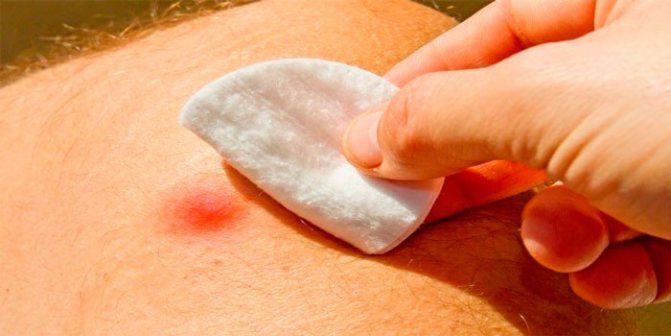
When carrying out specific therapy, a serum containing an antidote to scorpion venom is used. Unfortunately, it is produced only in the USA, so the vast majority of hospitals in Russia do not have it. Due to some similarity of zoological toxins, Anticobra anti-snake serum can be used as an antidote to a scorpion bite. Specific therapy is carried out only for severe poisoning, which occurs extremely rarely. When stung by a scorpion, it is also allowed to use anti-karakurt serum.
Detoxification therapy includes intravenous infusions and forced diuresis. If breathing is difficult, oxygen is inhaled.

During symptomatic therapy, the following medications are used:
- analgesics;
- glucocorticoids;
- antihistamines;
- anticholinergics (atropine);
- anticonvulsants;
- antiarrhythmics;
- antihypertensive drugs.
In case of severe intoxication, accompanied by severe hypotension and respiratory disorders, artificial ventilation and vasopressor support may be required.
Consequences
Local manifestations of toxicosis persist longer than general symptoms. Therefore, after mild poisoning, enlarged lymph nodes and swelling remain at the site of the scorpion bite. In more severe cases, after a scorpion sting, the following neurological symptoms may persist for a long time:
- paresthesia;
- loss of sensation;
- muscle fasciculations (twitching) of the affected area.
Destruction (destruction) of tissue may occur in the bite area, which requires surgical intervention.
What are the consequences of a scorpion sting
The toxicity of scorpion venom largely depends on its type and place of residence. It is noteworthy that even scorpions that live on the southern coast of the Mediterranean Sea are more dangerous than scorpions of the same species, but living on the northern coast. The greatest danger to humans, including death, is posed by scorpions from South and Central America, Mexico, North and South Africa, and the Middle East. In the countries of South and Southeast Asia, as well as in the south of the former USSR, deaths occur extremely rarely.
Scorpion venom is most dangerous for children and adults with weakened immune systems. In addition, the higher the location of the bite, the greater the likelihood of serious consequences for the victim’s health.
A scorpion sting is accompanied by severe pain, reminiscent of a burn. Painful sensations radiate along the nerve trunks and last for several hours, periodically subsiding and intensifying again. Later, itching appears and the sensitivity of the skin at the injection site decreases. After 30-40 minutes, redness and swelling develops in the affected area, in the middle of which a dark injection point can be seen. In some cases, blisters with clear liquid appear. Often, in addition to the symptoms described above, inflammation of the lymphatic vessels and lymph nodes is added.
A general reaction may develop between 5 minutes and 24 hours after exposure. Its signs:
- excitement, which later turns into drowsiness and apathy,
- feeling of fear,
- headache,
- chills,
- heart pain,
- heartbeat,
- dyspnea,
- nausea.
In addition, victims, especially children, may experience tremors and convulsive muscle twitching. Many reflexes weaken or disappear. Vision deteriorates, pupils dilate, eyes begin to water. The pulse accelerates, blood pressure becomes unstable. There is copious secretion of sweat, saliva and tears. The nose also runs. Body temperature rises and falls. Breathing becomes shallow and irregular. Death is possible within the first 20 (sometimes 30) hours. It is caused by paralysis of the respiratory muscles.
In mild cases, a scorpion sting can be compared to a bee sting. Its consequences:
- pain,
- slight redness of the skin around the injection site,
- edema.
However, even here an allergic reaction can develop, severe forms of which can be fatal.
It is also worth noting that in case of poisoning with scorpion venom, after the condition improves, a serious relapse may occur. Therefore, medical observation should continue for at least another 12 hours after all symptoms disappear.


